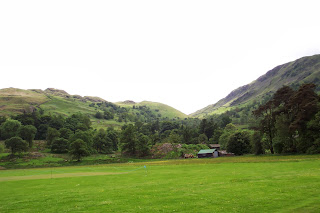Here you can just make out the park boundary wall running up the left hand side and coming round under the crags on the right. Due to the steepness of the slopes and the exposure of the site the wall often comes down and requires putting back up again.
The ranger team putting up two big wall gaps.
With the long history of grazing within the park, firstly by deer and then by sheep the trees that remain in the park are becoming very old. These old trees is one of the reasons why the park is so special, veteran trees are very important for wildlife due to the amount of dead wood and cavities which are ideal for nesting birds and roosting bats.
This is an ancient Alder tree which is completely hollow.
This is a large Silver Birch with an unusual shape, it must have been storm damaged at some point.
Due to the grazing pressures over the years there were no young trees coming up to replace the veteran trees so we had to think of a way to try and get some tree regeneration going and it was decided to remove sheep from the site and replace them with 12 hardy cattle. Natural tree regeneration rather than planting was preferred because you retain the local tree provenance and by putting cattle on the site these would trample down the bracken and break up the ground to allow some tree regeneration.
It has been 10 years since we put the cows in and I'm happy to say the trees are regenerating well and in a few hundred years time we will have our next generation of veterans trees.
Finally, this is the view from Glenamara Park, you can understand why the early settlers wanted to live here.








